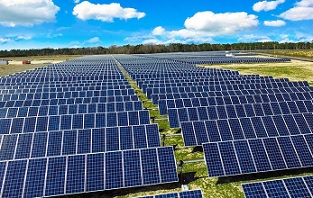|
Arguments against solar panels primarily center on the fact that they require more energy and fossil fuel-burning equipment to mine, manufacture, and transport than they save. Another argument is that the production method uses hazardous chemicals, which are more detrimental than beneficial. Then there is the problem of end-of-life disposal. When compared to nuclear energy, solar energy generates 300 times more waste. When it is feasible, recycling is not cost-effective, is energy intense, and has a negative environmental footprint. Gerardo E. Martínez-Solanas |
Earlier this year the New York Times published an opinion piece, “What Will We Do With Our Free Power?,” written by David Wallace Wells. The sheer optimism of the piece was a breath of fresh air. Rather than emphasizing the existential terror of a climate crisis that renewable energy may help us avert, the author focused on the plummeting costs of photovoltaic electricity, with facts to back up his assertions.
When evaluating California’s energy policy, the scale of the transformation the state has embarked upon could use a bit more optimism. Ratepayers who are exhausted by the current runup in electricity prices compared to other states would be encouraged if they understood the path we’re on is likely, within just a few more years, to compel providers to compete on price to serve electricity in abundance.
To test this theory, consider the return on investment for a solar power producer even at today’s prices. The installed cost for utility-scale photovoltaics is now down to under $1.50 per watt. This means that via a 25 year, 6 percent per year construction loan, the break-even cost for sold electricity is only $.05 per kilowatt-hour. That’s an annual average, but even in winter, break-even productivity sufficient to cover the construction loan payment would only be around $.08 per kilowatt-hour. At that rate, solar capacity can be profitably overbuilt to deliver energy even in winter.
 Not only has the cost of photovoltaics come way down, but tremendous advances are being made in stationary batteries that use less expensive materials, as well as solid-state batteries for mobile applications. With vehicle-to-grid technology and evolving pricing models, owners can opt to use their parked EVs to not only absorb surplus electricity from the grid, but also to sell electricity to the grid. This is not the least bit infeasible. If only 10 percent of California’s 14.3 million registered automobiles (that doesn’t include any commercial vehicles) were EVs with 50-kilowatt-hour batteries, they would have a total storage capacity of over 70 gigawatt-hours. California’s goal for total utility-scale storage by 2045 is only 52 gigawatt-hours. A decentralized grid with hundreds of thousands of photovoltaic arrays and mobile storage assets can significantly reduce the cost and scope of transmission upgrades.
Not only has the cost of photovoltaics come way down, but tremendous advances are being made in stationary batteries that use less expensive materials, as well as solid-state batteries for mobile applications. With vehicle-to-grid technology and evolving pricing models, owners can opt to use their parked EVs to not only absorb surplus electricity from the grid, but also to sell electricity to the grid. This is not the least bit infeasible. If only 10 percent of California’s 14.3 million registered automobiles (that doesn’t include any commercial vehicles) were EVs with 50-kilowatt-hour batteries, they would have a total storage capacity of over 70 gigawatt-hours. California’s goal for total utility-scale storage by 2045 is only 52 gigawatt-hours. A decentralized grid with hundreds of thousands of photovoltaic arrays and mobile storage assets can significantly reduce the cost and scope of transmission upgrades.
Critics of solar energy point to the land requirement. However, a significant percentage of solar power can be generated in existing urban areas. There is an estimated 10 billion square feet of usable rooftop space (360 square miles) for photovoltaics in California, sufficient to generate around 275,000 gigawatt-hours per year if all of it were utilized. By comparison, California’s total electricity consumption in 2022, from all sources, was 287,220 gigawatt-hours.
California’s stated goal for renewable electricity production is 500,000 gigawatt-hours per year by 2045. To generate that much electricity with photovoltaics — while assuming the actual panels only occupy 50 percent of the allotted space in order to make room for access and other balance-of-plant assets (most utility-scale solar farms don’t need that much extra space) — would require approximately 1,300 square miles. To put that into perspective, California sprawls over 156,000 square miles; its entire urban footprint is about 7,800 square miles. The state has over 25,000 square miles of rangeland, suitable for cattle, but also suitable for solar panels. The state also has over 60,000 square miles of desert. If roughly 50 percent of California’s available rooftop capacity were covered with private, inside-the-meter photovoltaics, that would generate 150,000 gigawatt-hours per year. Generating the other 350,000 gigawatt-hours using utility-scale solar fields would require another 900 square miles within an 85,000 square-mile pool of land that’s either rangeland or desert. That should not be difficult. Even if California bets everything on PVs, farms and irreplaceable habitats are not at risk.
One way to evaluate the concern over area is to compare the space requirements of other renewables. As discussed in WC#31, even if the BTUs in corn ethanol could be converted into electricity at 100 percent efficiency (with available technology, 40 percent is more likely), it would take 75,000 square miles of land to generate the 2045 goal of 500,000 gigawatt-hours per year in California. To do the same with land-based wind power would require nearly 4,000 square miles. As noted, even if we didn’t put any of them on existing rooftops, doing this with photovoltaics would only require 1,300 square miles. There is room in sunny California for as much solar power as we’ll ever need.
Criticisms of renewables extend well beyond the space required, of course. We have to consider the raw materials, machinery, and energy required throughout the life cycle from initial manufacture to ultimate recycling. Unfortunately, most in-depth studies are so obsessed with reporting the CO2 footprint, they don’t offer easily retrievable data on anything else. Stay tuned. But it’s clear that biofuel requires prodigious inputs of water and fertilizer, along with stupefying quantities of space, for a relatively small return. Wind turbines require ongoing maintenance, along with incredibly wasteful quantities of concrete and steel to build their foundations and towers. Both onshore, and especially offshore, wind turbines also wreak environmental havoc.
To achieve California’s electricity generation goals, the real comparison is not solar vs wind and biofuel. Solar easily wins that contest. Rather we should evaluate to what extent photovoltaic power belongs in a common sense energy mix that includes ultra-efficient combined cycle natural gas power plants along with nuclear power plants, augmented by sources with less scalability such as hydroelectric, geothermal, and various forms of waste-to-energy conversions. The ongoing and rapid decline in cost and required raw materials for photovoltaics and batteries, something that is not occurring with wind or biofuel energy, definitely positions photovoltaic power as increasingly competitive to conventional energy solutions. As always, the regulatory environment distorts costs and introduces a great deal of uncertainty into these comparisons. Nonetheless, continued investment in solar energy may provide that extra oomph that decisively lowers electricity prices in California.
If solar energy ultimately enables Californians to have access to abundant, affordable energy, it leads to tremendous positive ramifications. For example, a photovoltaic installation occupying less than ten square miles could generate enough electricity to desalinate one million acre-feet of seawater per year. A photovoltaic array roughly half that size could treat a million acre-feet per year of urban wastewater to potable standards. Abundant, affordable electricity can improve the cost-competitiveness of EVs, and make possible the revolution that has just begun in robotics and AI.
There are many ways to generate abundant electricity, and photovoltaics aren’t without drawbacks. But their potential to date, if anything, may have been understated even by their proponents.
_______________________
Californians for Energy and Water Abundance, a project of California Policy Center, was launched to build a coalition committed to abundance-oriented policies in California. The coalition aims to promote these solutions to the public and policymakers, and develop sample legislation to unlock California's energy and water potential to benefit all Californians.
 Edward Ring is the Director of Water and Energy Policy at the California Policy Center, which he co-founded in 2013. Ring is the author of Fixing California: Abundance, Pragmatism, Optimism (2021) and The Abundance Choice: Our Fight for More Water in California (2022).
Edward Ring is the Director of Water and Energy Policy at the California Policy Center, which he co-founded in 2013. Ring is the author of Fixing California: Abundance, Pragmatism, Optimism (2021) and The Abundance Choice: Our Fight for More Water in California (2022).
Comments powered by CComment